Japan
Wood Products Prices
Dollar Exchange Rates of 25th
Nov
2021
Japan Yen 114.7
Reports From Japan
Another huge stimulus budget
Japan's Cabinet has approved a record Yen 36.0 trillion
supplementary budget for fiscal 2021 to put the pandemicstricken
economy on a recovery track. The government
also plans to use 6.1 trillion yen that was carried over from
the fiscal 2020 budget.
See:
https://mainichi.jp/english/articles/20211126/p2g/00m/0na/041000c
and
https://www.japantimes.co.jp/news/2021/11/19/business/stimulus-plan-record/
In related news, the government has met with employer
groups and urged them to encourage their members to
raise wages by 3% or more next spring to achieve a
virtuous cycle of growth and wealth distribution. This is
part of the Prime Minister¡¯s ¡®new capitalism¡¯ strategy. A
government panel has recommended raising the pay
welfare workers, nurses and care-givers by 3% .
See:
https://asia.nikkei.com/Politics/Japan-s-Kishida-urgescompanies-to-raise-wages-3-or-more
Economy contracts
Japan's economy contracted in the third quarter as global
supply chain disruptions hit exports and business spending
plans. The expectation is that the economy has expanded
in the final quater as virus infection rates fall But, supply
issues pose increasing risks to the economy which is
export-dependent.
The Japanese economy shrank an annualised 3% in the
second quarter following the (revised) 1.5% gain in the
first quarter. The weak GDP growth contrasts sharply with
that of other advanced economies.
Machinery orders dip
The value of machinery orders received by the main
manufacturers operating in Japan declined by 10% in
September from the previous month. In the July-
September period it increased by just 1% compared with
the previous quarter.
In the last quarter of 2021 the value of machinery
orders
has been forecast to increase by 9% and private-sector
orders, excluding volatile ones, are expected to rise by 3%
from the previous quarter. But this was before new travel
restrictions for foreighers were introduced to try and stop
the spread of the Omicron variant.
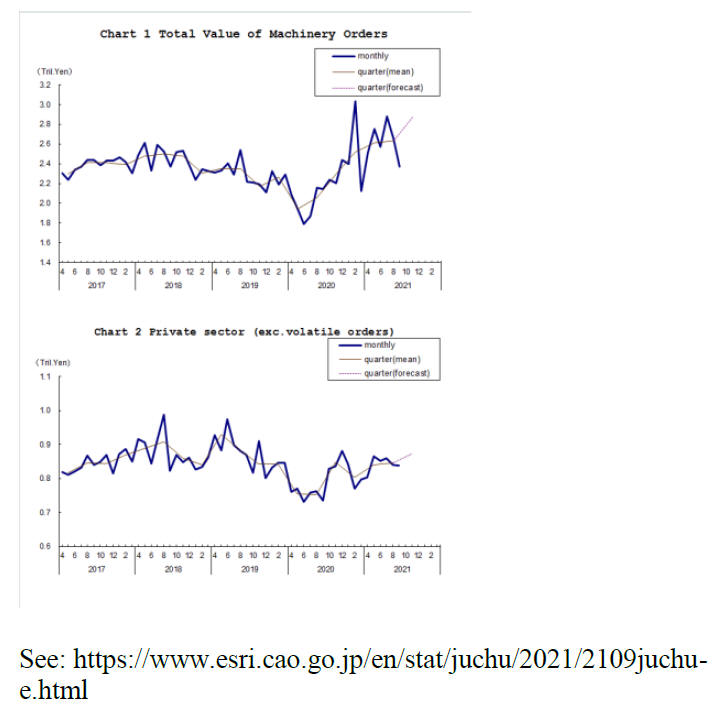
Foreign workers to be allowed to stay
It is reported that the government is considering revising
the current legislation to allow foreign blue-collar workers
to live and work indefinitely. The current law from 2019
allows "specified skilled workers" in 14 sectors such as
farming and construction to stay for up to five years but
without their family members.
The government has been urged by the private sector to
ease these restriction. The shrinking population has
become a serious problem for companies needing workers.
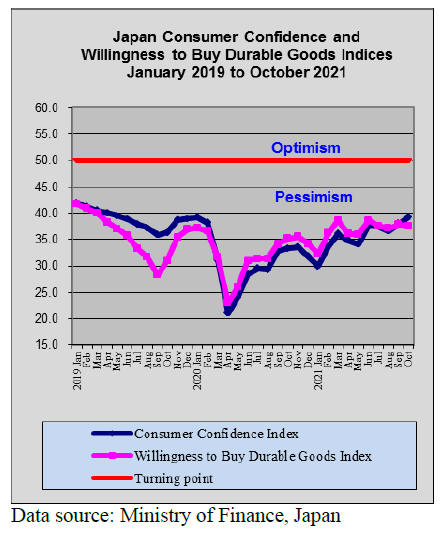
Space and more space please
Space is a bonus in Japanese homes and many newly built
homes now incorporate a feature of traditional Japanese
homes ¨C a doma - which is a room commonly used for
storage and where outside shoes can be worn.
Japanese homes always have an entrance area where
outdoor shoes can be removed before entering the living
area. Now, even more apartment buyers are asking for a
larger ¡°doma¡± in which they can walk around while
wearing footwear and store items for outdoor use. This
change is said to be related to the increase in outdoor
leisure activities but it is not likely to have any real impact
on the use of wood products in construction.
See:
https://www.asahi.com/ajw/articles/14475020
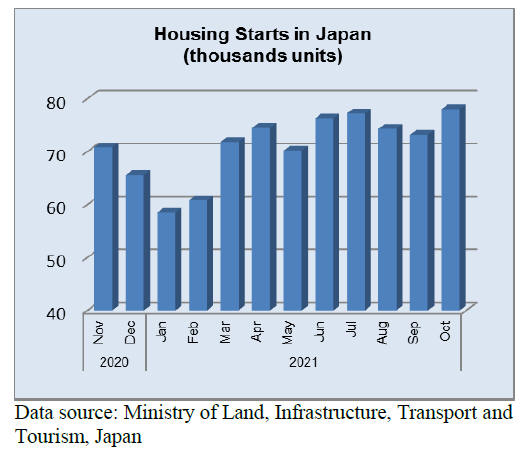
Weaker Yen, good or bad?
A weak yen, once hailed as giving exporters an advantage
in international markets, has now become headache for the
government as the rising costs of imports, especially oil, is
pushing up the cost of living. Also, as Japanese
manufacturers move off-shore the weak yen has become
less of a advantage for local exporters than it was.
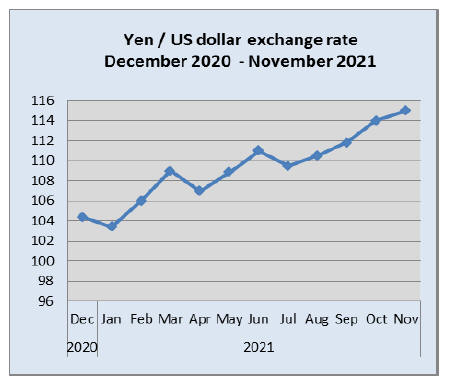
The US dollar hit 115.5 yen in late November, a
level not
seen since January 2017 driven by higher US treasury
yields as well as by the broad-based strength of the dollar
due to inflation concerns and strong growth momentum.
The reappointment of Jerome Powell as Federal
Reserve
Chair reinforced the perception that US interest rates
would rise next year further weakening the yen.
September was the low point this year for furniture
sales
Up to September, sales of wooden furniture remained
subdued as the country struggled to bring a fifth wave of
infections under control. However, recent data shows that
department store sales rose modestly in October as the
lockdown was lifted.
Sales at furniture stores such as Nitori Holdings rose
almost 4% in October from a year earlier according to the
Japan Chain Stores Association.
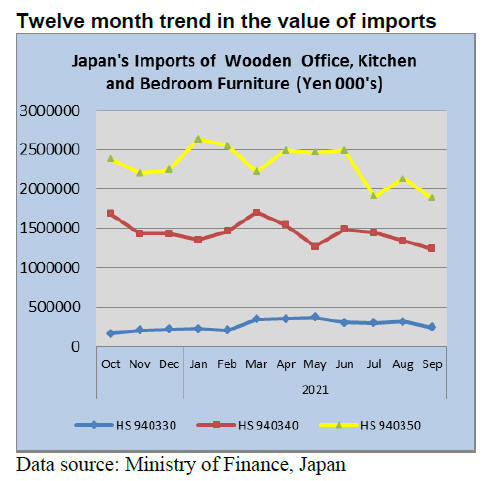
Office furniture imports (HS 940330)
The top shipper of wooden office furniture in September
this year was China whose share of imports was 73%,
down from the value of August shipments. The other
major shipper in September was the US with a 7% share, a
significant increase on the usual monthly shipments to
Japan. Most of the balance of September imports was
shipped from Taiwan P.o.C, Indonesia and Slovakia
(aprox 5% share each).
Year on year, the value of imports of wooden office
furniture (HS940330) rose over 40% in September and
compared to September 2019 there was a 32% increase in
the value of imports.

Kitchen furniture imports (HS 940340)
The value of Japan¡¯s wooden kitchen furniture imports
continued the downward trend that began in July this year.
September imports were 7% below the value of imports in
August.
Compared to 2020 the value of imports dropped 9% and
compared to 2019 there was a 10% decline. Exporters in
Germany and Italy once again made it into the list of top
20 shippers of wooden kitchen furniture.

Bedroom furniture imports (HS 940350)
Since the beginning of the second quarter of this year the
value of Japan¡¯s imports of wooden bedroom furniture
have been trending lower. Year on year, September 2021
imports were some 15% below that in 2020 but just
matched the level of 2019 imports.
Month on month, September arrivals of wooden bedroom
furniture were down 11% thus resuming the downward
trend.
The top suppliers in terms of value in September were
China (70%) and Vietnan (21%). Shipmets from Vietnam
in September were down sharply due to the impact of
pandemic lockdown measures imposed in the country.
The other top shippers in September were Malaysia,
Thailand and Indonesia which together accounted for
almost 15% of the value of arrivals taking up some of the
loss from Vietnam.

Trade news from the Japan Lumber Reports (JLR)
The Japan Lumber Reports (JLR), a subscription trade
journal published every two weeks in English, is
generously allowing the ITTO Tropical Timber Market
Report to reproduce news on the Japanese market
precisely as it appears in the JLR.
For the JLR report please see:
https://jfpj.jp/japan_lumber_reports/
Price hike of various items
Daiken Corporation (Osaka) increased the sales prices of
MDF produced in Malaysia and New Zealand since
November. This is second time of price increase followed
last April. Increase this time is more than 20% and further
increase may be necessary depending on prices of raw
materials. Increase is necessary to pass higher cost of
wood chip, adhesive and ocean freight. In particular,
adhesive prices climbed fast by increase of crude oil prices
and export restriction of urea by China so adhesive
manufacturers ask 1.4¨C 2.0 times higher prices compared
to the first quarter this year.
Daiken has two MDF plants in Malaysia with total
monthly production of 20,000 cbms and two plants in New
Zealand with total production of 35,000 cbms. The
demand is brisk so all the plants are running full.
Eidai Co., Ltd. (Osaka) announced to increase the prices
of all flooring since December 1. This is the second price
hike this year following July 1. Prices of domestic
softwood plywood, ocean freight, wooden board (MDF)
and adhesive all climbed so it needs to pass such higher
cost onto finished products.
Aica Kogyo (Nagoya) announced to increase the prices of
all the decorative board since December 21. The increase
will be 10-15% from present prices. It is facing high cost
of plywood, chemical products and energy. Particularly
plywood is becoming hard to buy and it is inevitable to
increase the prices for stable supply of the products.
South Sea (tropical) logs and lumber
After Daishin plywood quit using South Sea hardwood for
plywood manufacturing, import of South Sea hardwood
logs is almost none.
There are only two ships from PNG for the first eight
month and remaining mills now use veneer instead of logs.
With declining log production in Malaysia and chronic
high prices, there is no hope to use logs again. Lumber of
South Sea hardwood is also hard to come by because logs
are scarce in the South East Asia by rainy season so that
lumber prices are high.Chinese laminated free board
inventory is about two months in Tokyo region. Export
prices of Chinese red pine lumber and Indonesian mercusii
pine lumber are unchanged.
Domestic dealers worry about market price down by large
volume arrivals but now shipment takes more than two
weeks longer so rush arrivals are unlikely. Dealers are
selling cautiously as more demand to refurbish stores and
shops after state of emergency is lifted.
Declining log exports to China
The volume of exporting logs in August is 55,879 cbms,
51.8% less than last month and 44% less than same month
in last year. This is the lowest under 100,000 cbms since
January, 2020. It seems declining more after September.
The reasons are not only price increasing of freight and a
traffic congestion at the ports but also demands in China
declined.
There are restrictions on electric power supply and change
of policy at ports in China. Therefore, there is no hope for
recovering through the end of this year. There is also
another big problem which is keeping out logs at Taicang
port of Jiangsu province, one of major ports in China.
They are restricted to accept low value logs to have more
high-value-added goods so some sawmills around Taicang
port are forced to move out of the area.
About 80 to 90% of Japanese logs unloaded at Shanghai
port or Taicang port. This situation damages a lot to Japan.
Some export agents try to send logs to inland ports of
Chang Jiang River or the southern part of Zhejiang Sheng
in China but many of cargo ships stuck waiting outside
ports so the export agents had to pay almost Yen
1,000,000 of demurrage a month.
Ocean freight used to be US$50,000 for 2,500 cbms of a
ship until last year but now it climbed to US$120,000 so
many log exporters hesitate to export logs to overseas
from Japan. There are many logs which are over 18 cm in
diameter sitting at exporting ports.
The price of export logs was around ¥11,000 (FOB, cbm)
in southern part of Kyusyu, Japan but now they are less
than ¥10,000.
Orders from China are declining as export of cedar lumber
for the U.S. market is slowing as the U.S. housing market
is weakening. Cedar lumber inventories are high on both
side of China and the U.S.A. so even if the market in the
U.S.A. rebounds, there is no chance to recover for some
time.
Cedar log export prices for China increased by US$10 on
every ship until last July then the prices peaked at
US$170-180 per cbm C&F then dropped to US$165 in
August and there are no counter orders from China.The
volume of exporting logs to China in January to July are
794,761 cbms, 28.7% more than same period of last year.
This is 30% over for the same period of last year.
In August, the pace slowed down and it would be
1,070,000 cbms for 2021. This result would be lower than
last year which was 1,157,000 cbms.
Also exporting Japanese cedar lumber to the U.S. is
declining. The volume of lumber in August was 3,543
cbms, 34.8% less than last month and 35.1% less than
same month of last year due to loss of demands, not
enough cargo ships and expensive freight. Spot price of
40¡¯ container is now around US$15,000, which was
US$4,000 last year. It can contain 45 cbms of lumber.
Climbing adhesive prices
Soaring adhesive prices are squarely impacting wooden
board cost. Supply of raw materials of adhesive such as
urea sharply dropped after electric supply is disrupted in
China so prices of adhesive climbed in Asia.
Prices of urea and methanol climbed by over 30% in one
month and the prices of melamine soared doubled in last
four months. Some overseas MDF plants shutdown
temporarily by shortage of adhesive. Manufacturers of
MDF and particleboard are hurriedly increase the sales
prices as these products need large amount of adhesive.
Raw material prices of adhesive started climbing since late
2020 so the manufacturers of MDF and particleboard
increased the sales price by 5-10% in spring of 2021.
Urea prices stayed almost unchanged at US$200 per
ton
for whole year of 2020 then it started climbing to US$350
in March, US$500 in June and over US$600 by October
2021.
Ethanol prices were less than US$200 in June 2020 then
went up to about US$400 in December 2020, US$350-380
in July and escalated over US$500 in October. Melamine
prices were US$700 in 2020 then inflated over US$3,000
in October 2021.
Urea and ethanol are both used for urea or melamine
adhesive. Some Indonesian plywood manufacturer failed
producing some items by shortage of adhesive. The largest
reason of soaring adhesive prices is supply reduction by
China, which has 40% share of urea supply in the world.
China stopped importing coal from Australia by political
reason, which is main fuel for electricity in China so
power supply failed and disrupted production of urea. Also
urea is mainly used for fertilizer in China so supply of urea
for adhesive is reduced. After all, all the wooden board
manufacturers need to increase the sales prices by soaring
adhesive prices.
|